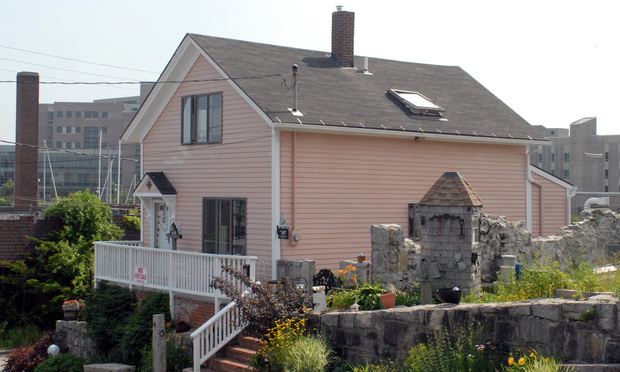The Supreme Court's 'Little Pink House' Case Hits the Silver Screen
The film recounts the 2005 eminent domain case "Kelo v. New London."
April 19, 2018 at 12:47 PM
4 minute read
The original version of this story was published on National Law Journal
 The original Kelo home. Credit: AP
The original Kelo home. Credit: AP A movie that tells the story of a landmark eminent domain case before the U.S. Supreme Court—and makes it interesting, even moving—debuts in movie theaters starting April 20.
“Little Pink House” recounts the long journey of Susette Kelo, a New London, Connecticut, homeowner who fought the city's plans to tear down her house and others to make room for a Pfizer Inc. facility, a hotel and other private uses.
Portrayed by actress Catherine Keener, Kelo's plight and hardscrabble life story made the villains of the movie—government and corporate officials eager to make the city “more hip”—seem even more diabolical.
Kelo went all the way to the Supreme Court, and even though she lost 5-4 in the 2005 ruling Kelo v. City of New London, it was a case of winning by losing. Instead of licking its wounds, Institute for Justice, which represented Kelo, launched a powerful nationwide campaign to end “eminent domain abuse” when it is used to benefit private companies rather than for public uses such as building roads or hospitals.
“A lot of good has come from this terrible decision,” said Scott Bullock, the institute's president, who argued the Kelo case.
The campaign turned the 2005 Kelo decision into one of the most-hated Supreme Court decisions in modern history. Numerous states have reformed their eminent domain policies. Meantime, instead of being demolished, Kelo's pink house was moved, board by board, to downtown New London to commemorate the case. A pillar displaying the words “Not for Sale” sits in front of the home. Kelo has since moved away from New London.
Even before the Supreme Court loss, Institute for Justice made Kelo the public face of the issue, a reminder that sometimes public relations can be an important component of litigation strategy. In a sense the fast-paced movie, which has been in the making since 2014, continues the campaign, though Institute for Justice did not fund the film.
“Memories are short,” Bullock said. “It has been 13 years since the decision, and several states have not changed their laws. We're very happy the movie was made.”
Courtney Balaker, writer-director of the movie, said it was challenging to make eminent domain understandable in the movie while keeping it interesting. “We didn't want a boring, didactic scene,” she said. But in several separate scenes, the concept becomes clear. “We knew we were going to have to explain it, so we laid it out,” including the Fifth Amendment provision behind it.
The movie includes a brief Supreme Court scene, and the dialogue was drawn from the transcript of the case, Balaker said in an interview. Much of the filming took place in Vancouver, British Columbia, she added, and the city's Orpheum Theatre was transformed into a courtroom for the occasion.
And if you wonder why only seven justices are portrayed in the scene, that is because the moviemakers were being accurate. Only seven of the nine justices were in attendance on Feb. 22, 2005, when the case was argued.
Chief Justice William Rehnquist was ill, and Justice John Paul Stevens' flight from out of town was delayed, so Justice Sandra Day O'Connor presided. “We knew there were only seven that day, and we wanted to get it right,” Balaker said.
This content has been archived. It is available through our partners, LexisNexis® and Bloomberg Law.
To view this content, please continue to their sites.
Not a Lexis Subscriber?
Subscribe Now
Not a Bloomberg Law Subscriber?
Subscribe Now
NOT FOR REPRINT
© 2025 ALM Global, LLC, All Rights Reserved. Request academic re-use from www.copyright.com. All other uses, submit a request to [email protected]. For more information visit Asset & Logo Licensing.
You Might Like
View All
Alston & Bird Adds M&A, Private Equity Team From McDermott in New York
4 minute read
Weil Lures DOJ Antitrust Lawyer, As Government Lateral Moves Pick Up Before Inauguration Day
5 minute read
Looking to the Future of the FDA and Its Impact on Drug Regulation in 2025
4 minute readTrending Stories
Who Got The Work
J. Brugh Lower of Gibbons has entered an appearance for industrial equipment supplier Devco Corporation in a pending trademark infringement lawsuit. The suit, accusing the defendant of selling knock-off Graco products, was filed Dec. 18 in New Jersey District Court by Rivkin Radler on behalf of Graco Inc. and Graco Minnesota. The case, assigned to U.S. District Judge Zahid N. Quraishi, is 3:24-cv-11294, Graco Inc. et al v. Devco Corporation.
Who Got The Work
Rebecca Maller-Stein and Kent A. Yalowitz of Arnold & Porter Kaye Scholer have entered their appearances for Hanaco Venture Capital and its executives, Lior Prosor and David Frankel, in a pending securities lawsuit. The action, filed on Dec. 24 in New York Southern District Court by Zell, Aron & Co. on behalf of Goldeneye Advisors, accuses the defendants of negligently and fraudulently managing the plaintiff's $1 million investment. The case, assigned to U.S. District Judge Vernon S. Broderick, is 1:24-cv-09918, Goldeneye Advisors, LLC v. Hanaco Venture Capital, Ltd. et al.
Who Got The Work
Attorneys from A&O Shearman has stepped in as defense counsel for Toronto-Dominion Bank and other defendants in a pending securities class action. The suit, filed Dec. 11 in New York Southern District Court by Bleichmar Fonti & Auld, accuses the defendants of concealing the bank's 'pervasive' deficiencies in regards to its compliance with the Bank Secrecy Act and the quality of its anti-money laundering controls. The case, assigned to U.S. District Judge Arun Subramanian, is 1:24-cv-09445, Gonzalez v. The Toronto-Dominion Bank et al.
Who Got The Work
Crown Castle International, a Pennsylvania company providing shared communications infrastructure, has turned to Luke D. Wolf of Gordon Rees Scully Mansukhani to fend off a pending breach-of-contract lawsuit. The court action, filed Nov. 25 in Michigan Eastern District Court by Hooper Hathaway PC on behalf of The Town Residences LLC, accuses Crown Castle of failing to transfer approximately $30,000 in utility payments from T-Mobile in breach of a roof-top lease and assignment agreement. The case, assigned to U.S. District Judge Susan K. Declercq, is 2:24-cv-13131, The Town Residences LLC v. T-Mobile US, Inc. et al.
Who Got The Work
Wilfred P. Coronato and Daniel M. Schwartz of McCarter & English have stepped in as defense counsel to Electrolux Home Products Inc. in a pending product liability lawsuit. The court action, filed Nov. 26 in New York Eastern District Court by Poulos Lopiccolo PC and Nagel Rice LLP on behalf of David Stern, alleges that the defendant's refrigerators’ drawers and shelving repeatedly break and fall apart within months after purchase. The case, assigned to U.S. District Judge Joan M. Azrack, is 2:24-cv-08204, Stern v. Electrolux Home Products, Inc.
Featured Firms
Law Offices of Gary Martin Hays & Associates, P.C.
(470) 294-1674
Law Offices of Mark E. Salomone
(857) 444-6468
Smith & Hassler
(713) 739-1250







